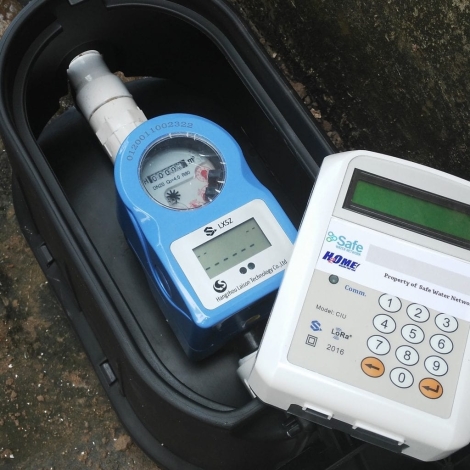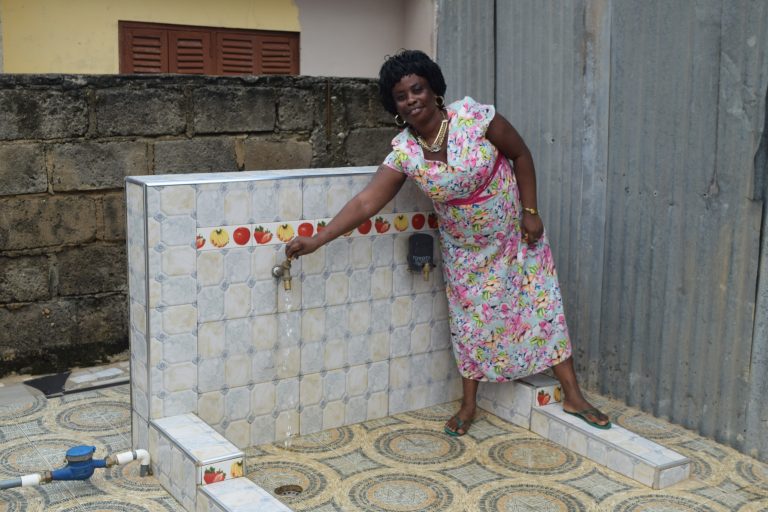Editor’s note: This is the first in a two-part series about lessons learned during Safe Water Network’s experience household connections for water supplies in Ghana. The first article outlines a protocol for plumbing installation. and the second maps a path to financial sustainability.
Many of us would find it hard to imagine a world in which we were unable to simply turn on a faucet and receive an endless supply of safe water. But for more than two billion people across the globe, getting any kind of water is an arduous ordeal. More often than not, it is women and girls who bear the burden of journeying to water sources multiple times a day to retrieve water. These trips can be difficult and potentially dangerous, as these water carriers can face extreme heat, wild animals, and even unwelcome strangers. The risks don’t stop there: bacteria, viruses, and pollutants can make this water detrimental to one’s health, or even fatal. Women and girls, again, are the ones who usually care for sick family members. This takes them away from school and work, reinforcing their disempowerment.
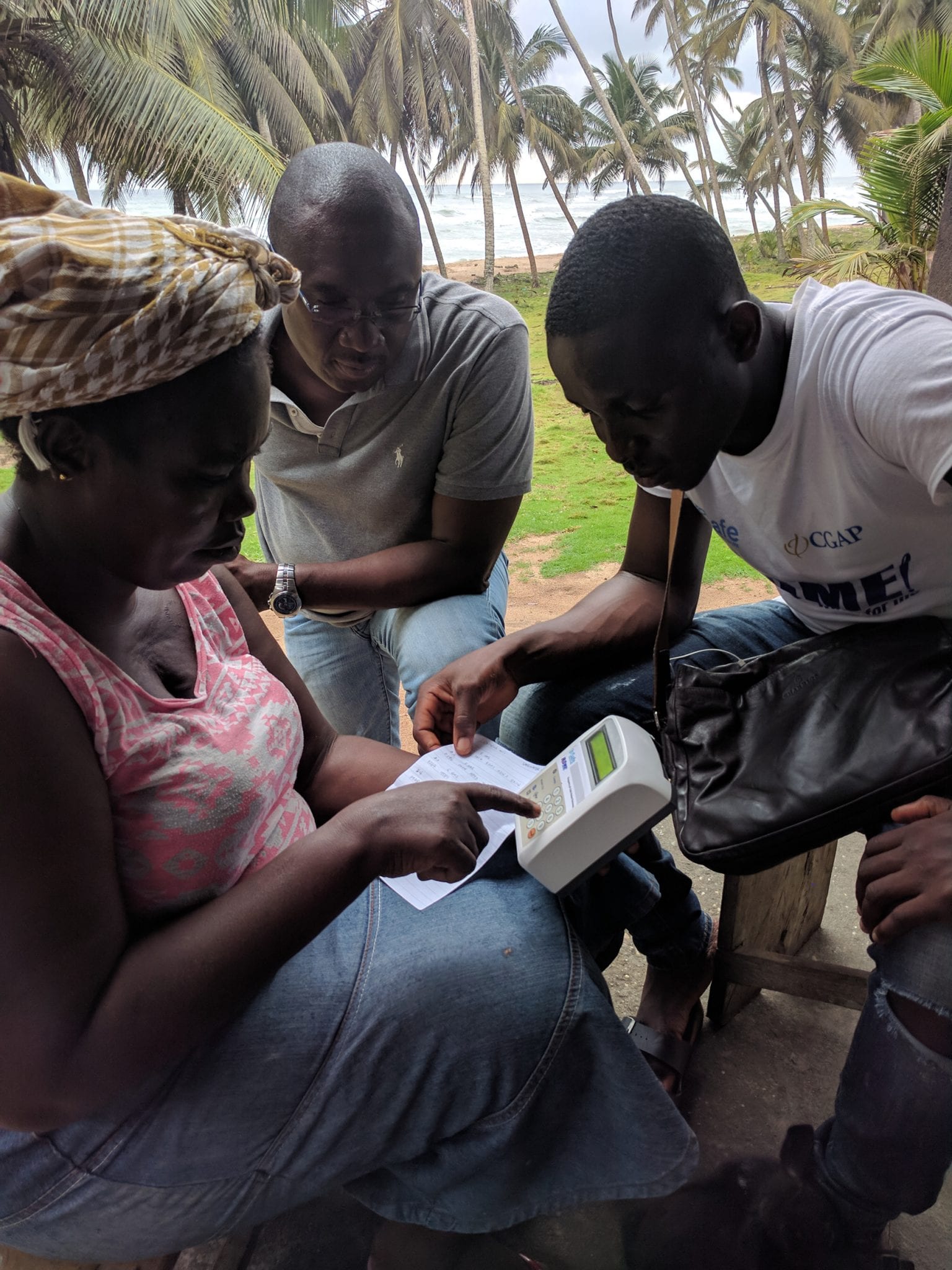
A Decentralized solution: small water enterprises
We at Safe Water Network—a not-for-profit committed to bringing safe, reliable, and affordable water to those most in need—understand this all too well. This is why we build and advocate for small water enterprises, locally owned and operated water treatment plants providing communities with water compliant with relevant national quality standards. Sustainability is a key focus of our model, which is why we use a market-based approach that ensures the long-term viability of each enterprise.
At the core of each small water enterprise is a water station, which accesses ground- or surface-water. Increasingly, we use solar photovoltaic technology to power the stations’ water pumps, enabling safe water access to off-grid communities, insulating stations from electricity rate escalations, protecting our operational equipment from grid power quality fluctuations, and reducing our dependence on carbon-heavy energy sources. Each station is sited and sized for the community’s needs and utilizes water treatment technology (including reverse osmosis, slow- and rapid-sand filtration, ultrafiltration, etc.) that addresses the specific challenges of the water source in question.
Our model empowers partnering communities through local ownership of their water station, which is operated by the residents themselves (with oversight from Safe Water Network). Consumers pay $0.02 – $0.07 per five gallons of water—affordable to people living on $1 – $2.50 per day. This revenue covers operating, maintenance, and replacement costs, ultimately keeping the station operating sustainably. To address additional demand, a station’s reach can be expanded through sub-stations, delivery services, and direct household connections.
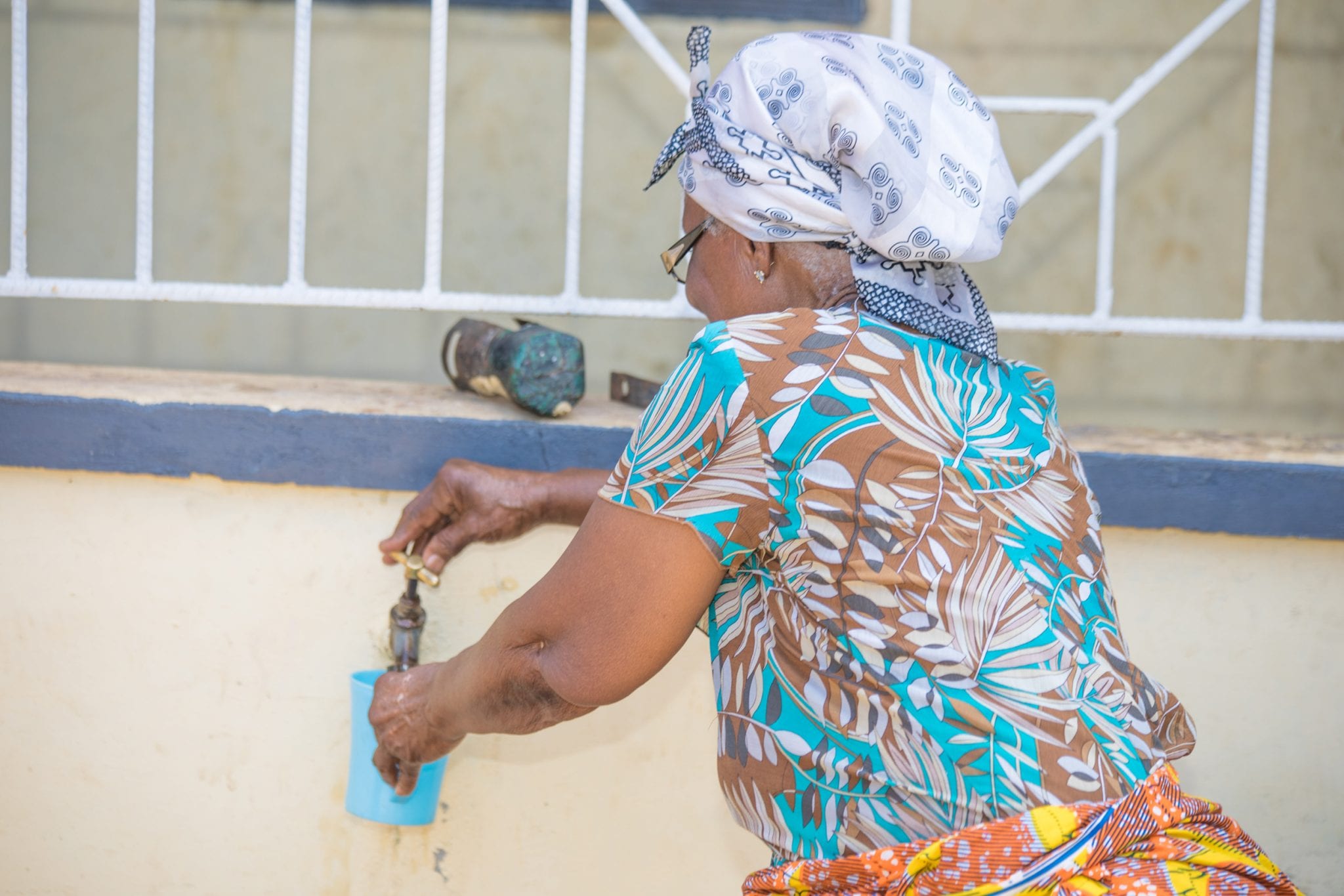
Leveraging more than ten years of on-the-ground experience and consumer research in Ghana and India, we’ve identified convenience as a key driver of water sales. Furthermore, we’ve found that there is a geospatial element to this convenience: household penetration within 100 meters of a water station currently stands at 86%, dropping to 62% beyond 100 meters, and to 28% beyond 500 meters. To increase convenience for residents in Ghana, we’ve implemented various optimizations, such as the integration of mobile money into our operations, automated 24/7 water dispensers, and household connections (HHCs) that bring water straight to consumers’ premises and incorporate LAISON Multi-Jet STS Prepaid Water Meters for improved water management. Customers can top up their water meters using LAISON customer interface units, which are included with each meter. According to Joseph Owusu Ansah, Safe Water Network’s Head of Operations in Ghana, these HHCs can take two forms: “For houses that have existing plumbing, the connection is tied into the system, and water flows into the relevant areas of the house (the kitchen, washrooms, bathrooms, etc.). For those without plumbing, a standpipe is created near the house or within a compound, and water is fetched when needed.”
The home stretch: household connections in Ghana
Our HHC program has grown steadily in Ghana, thanks in large part to volunteers from Engineers Without Borders USA (EWB-USA), who helped us scope and design the technical requirements needed to retrofit our existing water stations with the operational capacity to manage a larger network of HHCs. Members of EWB-USA’s Engineering Service Corps program, these volunteers are lending their expertise through a program made possible by funding from the Conrad N. Hilton Foundation and AECOM. Mike Paddock, a Chief Engineer for EWB-USA, describes the beneficial alignment of priorities between the two organizations: “Unlike other NGOs who install water systems and provide only initial training, Safe Water Network is committed to sustainably operating and maintaining its water systems. We have not worked with another organization that has a sustainability track record as good as Safe Water Network.”
HHCs reduce time and travel for water collection, thereby reducing the chance of recontamination between the point of collection and the point of consumption. Furthermore, water from HHCs is usually consumed immediately, reducing the recontamination risk associated with lengthy water storage. Owusu Ansah sees this service as a significant advantage: “The consumer has easy access to water in the home, as well as improved quality. The possibility of recontamination due to transport and storage is completely ruled out.” Families spared waterborne illness are families that can work, grow food, and go to school. Beyond drinking, safe water is used for cooking, personal hygiene, washing dishes and clothing, and countless other purposes.
These are all worthwhile reasons to pursue HHCs, but at the end of the day, we are responding to our consumers’ demand for convenience. Households with direct connections use volumes up to four times greater than those of customers using our traditional standpipes. Greater volumes sold yield increased revenue and more funds for operations and maintenance, which in turn ensures a sustainable supply of safe water for the village. Paddock contends that quantity and quality need not be mutually exclusive: “I am impressed with Safe Water Network’s obsession with finding operational cost efficiencies without compromising quality. This allows them to provide safe water to even the most vulnerable in a community.”
Lessons learned from a successful HHC program: technical and economic
With agreement on the social and economic benefits of HHCs, Safe Water Network and EWB-USA recognized that an initial protocol for the HHC program needed to be developed if the roll-out of larger networks was to be successful.
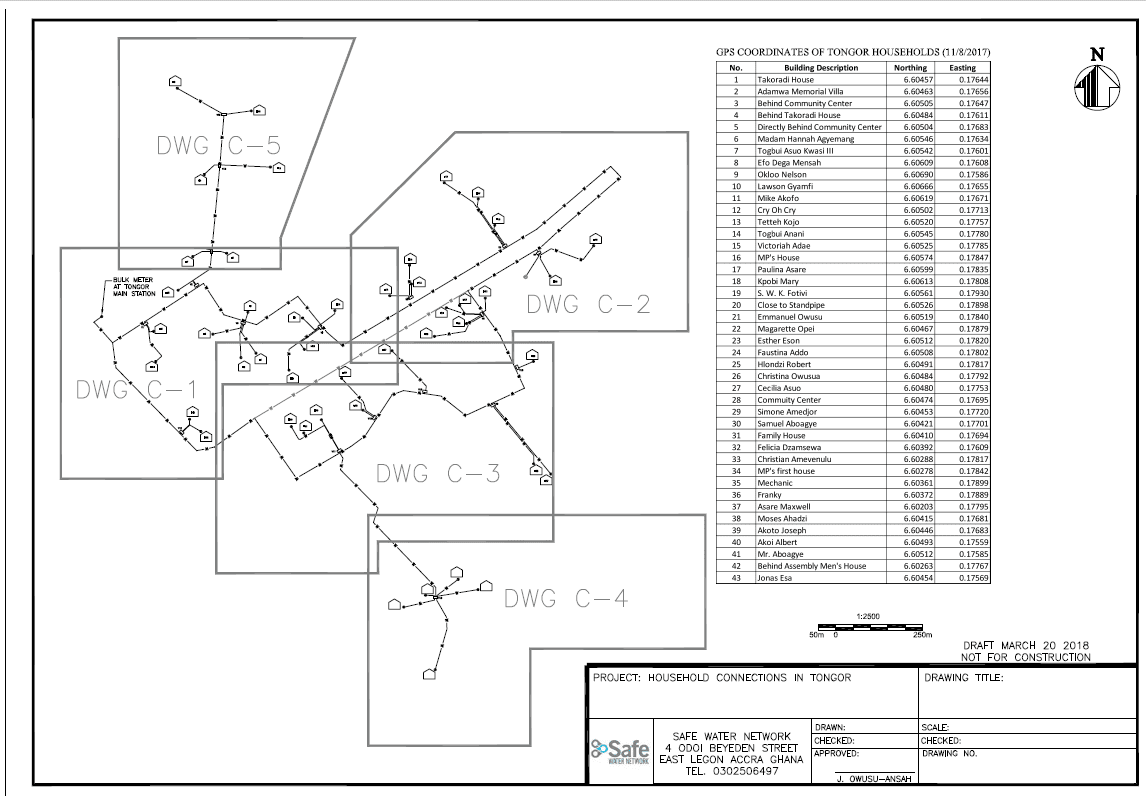 First, a number of technical considerations needed to be addressed:
First, a number of technical considerations needed to be addressed:
- What is the ultimate service area for these HHCs, and how can its implementation be phased in an economic manner?
- Can a given community’s water source satisfy the increased demand?
- Will the station be able to meet the increased volume?
- Will the size of the pipes be adequate to serve all households?
- How can we isolate lines in case of leaks and make maintenance easier?
Second, a number of economic considerations needed to be addressed before the scoping and design could begin:
- Are the income levels in a selected community sufficient to sustain the system after the initial investment?
- Can community members afford the initial cost to hook up to the system?
Technical considerations
With a pilot program based in the village of Tongor, located in Ghana’s Volta Region, Safe Water Network and EWB-USA started to tackle the program’s technical considerations:
- Siting the Station. When a HHC program is proposed in a community, Safe Water Network produces a simple diagram of the station, together with any sub-stations and standpipes used to extend the water’s reach. A team surveys the town and identifies the suburbs/sections where HHCs will be most in demand. This diagram is used to develop a service plan for the area. The plan can take a more definitive shape using EPANET, a software application designed by the United States Environmental Protection Agency, which models water distribution systems to inform phasing decisions and ensure that investments are made wisely.
- Water Supply and Demand. To determine whether a community’s water source can satisfy the increased demand brought about by HHCs, pump tests are conducted to assess the potential yield of the water source. To conclude whether a station will be able to meet the increased volume, a review of the selected area is conducted to confirm whether it is technically suitable.
- Pipe Suitability. The suitability of the pipelines’ size is dependent on the peak hourly demand that HHCs facilitate. The solution differs depending on whether the HHCs are being built for a completely new water station or whether we are retrofitting an existing station:
- Newly designed stations. Once a community suburb/section is selected, a route for the pipeline is designed with the help of engineering software. The pipeline is then laid and hooked up to the station.
- Retrofits of existing stations. In an otherwise modular system, pipelines are the one limiting factor. The existing network is modeled to determine the number of HHCs that can be added without compromising the service. In situations where the number of HHCs exceeds the capacity of the existing pipelines, we may need to lay additional water mains, increasing the capital cost of the project.
- Leak Detection. Each household connection is installed with a prepaid digital water meter, and a community will have several bulk meters. Leaks can be quickly identified by discrepancies in volumes between the household and bulk meters.
Part 2: Economic Considerations
In our next installment, we will take a look at the economic considerations that preceded the scoping and design phase of our HHC program, as well as complementary technologies that Safe Water Network is integrating with our HHCs, such as the use of mobile money.
About the Author
Jonathan McGrath serves as the Communications & Engagement Manager at Safe Water Network.
